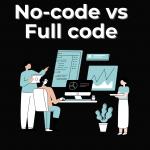Low-code development is transforming the landscape of software application creation by enabling rapid development with minimal coding efforts. This approach empowers both professional developers and non-technical users to build applications swiftly, reducing time-to-market and costs. However, the convenience and speed of low-code development are accompanied by unique security considerations that demand careful attention.
In the ever-evolving world of technology, the need to secure low-code applications is paramount. This introduction highlights the critical importance of addressing security challenges in low-code development. As organizations increasingly adopt low-code platforms to meet their software needs, it becomes imperative to ensure the integrity, confidentiality, and availability of the applications produced through these platforms.
This article will delve into the core security aspects of low-code development, covering data protection, authentication, authorization, compliance, and incident response. By gaining insights into these security considerations and implementing best practices, organizations can harness the benefits of low-code development while safeguarding against potential vulnerabilities and threats in today’s dynamic digital environment.
Why do companies adopt multiple low-code platforms for software development?
In the realm of modern software development, low-code platforms have emerged as powerful tools that enable organizations to streamline application creation, reduce development timelines, and democratize the development process. While these platforms offer substantial advantages, organizations are increasingly recognizing that a one-size-fits-all approach may not align with the complex and diverse demands of their digital landscapes. Consequently, many companies are opting to employ multiple low-code platforms, each serving specific needs and objectives.
Diverse Application Requirements:
Companies often have a wide array of application requirements. Some applications may be simple and focused on automating internal processes, while others may be complex customer-facing solutions. Multiple low-code platforms allow organizations to match the right platform to the specific needs of each project. For example, a platform optimized for data analytics and reporting may be selected for a business intelligence project, while a different platform is chosen for HR process automation.Integration Complexity:
Many companies grapple with legacy systems and diverse technology stacks. Different low-code platforms often offer unique integration capabilities and connectors. To seamlessly integrate with a variety of systems, companies may deploy multiple platforms. This approach ensures that each application can interact with the necessary data sources and systems while maintaining consistency and efficiency.Scalability and Performance:
Scalability is a crucial consideration, especially for applications with varying usage patterns. Some low-code platforms may perform better under high user loads or handle large datasets more efficiently. Organizations may opt for multiple platforms to ensure they can scale applications as needed without compromising performance.Regional or Departmental Autonomy:
Large organizations with diverse operations often grant regional or departmental autonomy to make technology decisions. Different business units may have specific needs, compliance requirements, or preferences for low-code platforms. Deploying multiple platforms accommodates these differences, allowing each unit to choose the solution that aligns best with its objectives while maintaining centralized governance.Risk Diversification:
Relying solely on one low-code platform can be risky if the platform faces unexpected issues, vendor changes, or disruptions. Using multiple platforms spreads the risk, reducing the organization’s vulnerability to a single point of failure. This diversification strategy ensures that even if one platform encounters challenges, other projects can continue without interruption.
Safeguarding a Multi-LCNC Environment: Ensuring the Security of Multiple Low-Code No-Code Platforms
Securing a Multi-LCNC (Multiple Low-Code No-Code) environment involves safeguarding applications and data developed using various low-code and no-code platforms. These environments empower organizations to create software rapidly but require robust security measures to protect against potential vulnerabilities and threats.
User Authentication and Authorization
User authentication and authorization are pivotal aspects of securing a Multi-LCNC environment. Robust authentication methods like multi-factor authentication (MFA) bolster identity verification, ensuring that only authorized users gain access to the platform. Equally crucial are access controls, which define what resources and data each user or role can access. Granular access controls based on roles and responsibilities prevent unauthorized access to sensitive areas within LCNC applications, enhancing overall security. Effective user provisioning and de-provisioning procedures ensure that access rights are granted and revoked in a timely and controlled manner, reducing the risk of unauthorized access.
Data Encryption
Data encryption plays a pivotal role in safeguarding sensitive information within a multi-LCNC environment. Encryption should be applied both in transit and at rest. When data is in transit, using protocols like HTTPS ensures that information exchanged between users’ devices and LCNC platforms remains confidential, thwarting eavesdropping and interception attempts. Equally important is encrypting data at rest, which secures information stored within the LCNC platforms and associated databases. Even if an unauthorized entity gains access to storage systems, the data remains indecipherable without the appropriate decryption keys.
Application Security
Ensuring the security of applications developed within a multi-LCNC environment is paramount. Code reviews provide a systematic examination of application source code, identifying and addressing potential security vulnerabilities. Concurrently, vulnerability scanning, performed using automated tools, helps proactively detect known vulnerabilities within applications. Input validation is another crucial aspect, preventing common attacks like SQL injection and Cross-Site Scripting (XSS) by ensuring that user inputs are properly validated and sanitized before processing, thereby safeguarding the application’s functionality and data integrity.
Logging and Monitoring
To detect and respond to security incidents promptly, comprehensive event logging and monitoring are essential. Event logs capture user activities and system events, providing a detailed record of actions within the LCNC environment. Integration with a Security Information and Event Management (SIEM) system enhances monitoring capabilities by correlating and analyzing log data. This enables the early identification of suspicious activities or potential security threats, facilitating proactive responses and threat mitigation.
Incident Response Plan
In the event of a security breach, an effective incident response plan is vital. The plan should delineate roles and responsibilities, communication protocols, and specific actions to be taken to mitigate the breach. Regular staff training on the plan, coupled with simulated exercises and drills, ensures that personnel are well-prepared to respond effectively during real security incidents. Detailed documentation of all security incidents, including timelines, actions taken, and lessons learned, not only assist in improving future incident responses but also aids in compliance reporting and maintaining a proactive security posture.
The Bottom Line
In the context of low-code development, security considerations are paramount. While low-code platforms offer the advantage of rapid application development, they also introduce unique security challenges. Prioritizing security involves robust authentication, data validation, encryption, and API security. Additionally, monitoring and logging are crucial for detecting and responding to security incidents. Neglecting these aspects can lead to vulnerabilities and data breaches. Thus, a security-first mindset is essential to ensure that the benefits of low-code development are not compromised by potential risks, safeguarding both the functionality and integrity of the applications created.




















